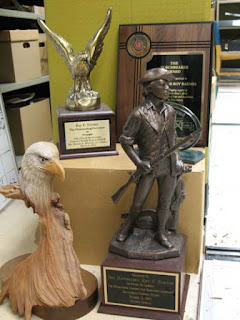 We began preparing for the move by asking the question, "What do we want to move to the new Special Collections Building?" While it seems like that question should illicit the simple answer of "everything" we quickly discovered it wasn't so easy.
We began preparing for the move by asking the question, "What do we want to move to the new Special Collections Building?" While it seems like that question should illicit the simple answer of "everything" we quickly discovered it wasn't so easy.Before we can move anything, we need to figure out what we have. And, since we have filled every nook, cranny, and spare closet available over the past thirty years, both in our space at the Main Library building and in our off-site storage locations, accounting for everything is a time intensive activity. Last spring we were lucky enough to have a volunteer who did a box count of fifty-seven rows of shelving in the Main Library, and I was able to do a general survey of our holdings at three off-site storage facilities. Our shelf by shelf inspection at Main led us to several conclusions:
Below: Objects on the loose! (a small sample)
- There are over 35 types of containers (which include document stor age boxes, record center boxes, and specialty and oversize boxes)
- Many of our containers are either not sturdy enough to withstand the move or their current contents are too heavy.
- There are hundreds of objects that are loose on the shelves.
- Several collections have materials that can be deaccessioned or transferred to another repository.
- In addition to dealing with actual collection boxes, we also have many items that will need to be stored in the high density storage area that are not collections, but are necessary for our operations (including exhibit materials and publications).
- According to my assessment, we have approximately 4,500 boxes of various sizes at our off-site facilities. Only brief, preliminary inventories were done on these boxes and many of them are also not sturdy enough for the move.
 The “Identify” step has pushed us through what feels like the seven stages of grief, beginning with shock and denial, progressing to guilt, anger, and bargaining, but hope and acceptance are right around the corner. This part of the move process gives us a much better idea of the road ahead and what kind of timeline we’re looking at. Fearlessly we advance toward step 2: creating an inventory of items. Stay tuned.
The “Identify” step has pushed us through what feels like the seven stages of grief, beginning with shock and denial, progressing to guilt, anger, and bargaining, but hope and acceptance are right around the corner. This part of the move process gives us a much better idea of the road ahead and what kind of timeline we’re looking at. Fearlessly we advance toward step 2: creating an inventory of items. Stay tuned.Above: Diligent student worker advancing the
relabeling project of Senator Russell's collection.
Post by Kat Stein, Head of Arrangement and Description, Russell Library





No comments:
Post a Comment